Chapter 5. Overview of the case study areas in Saskatchewan and Yukon
This chapter provides a labour market and economic overview of the four case study regions as well as a description of their employment and training services. It also presents the results from an OECD LEED statistical tool which looks at the relationship between skills supply and demand at the sub-national level. To better understand the role of the local level in contributing to job creation and productivity, this study examines local activities in four case study areas across Saskatchewan and Yukon: 1) Whitecap Dakota First Nation; 2) Regina; 3) Whitehorse; and 4) Dawson City.
Overview
In-depth fieldwork for this study was undertaken in four areas across Saskatchewan and Yukon. These areas were selected after consultation between the OECD and a steering group of federal and provincial and territorial government representatives. In Saskatchewan, the study examined local activities in Whitecap and Regina. In the Yukon, local activities were examined in the municipalities of Whitehorse and Dawson City. This chapter begins by giving a labour market and economic overview of the four case study areas as well as a description of the employment and training services that are available in each. This is followed by the results of a statistic tool developed by the OECD LEED Programme, which looks at the relationship between supply and demand for skills at the sub-national level.
Whitecap Dakota First Nation, Saskatchewan
Whitecap is a small community located 26 kilometres south of Saskatoon (Whitecap Dakota First Nation, 2015). Formerly known as Moose Woods, it was established in 1889 by Order-in-Council. The Whitecap Dakota First Nation is part of the larger Dakota Nation, whose traditional governance structure was called the Seven Council Fires or Oceti Sakowin, and whose traditional lands extended into both Canada and the United States. The reserve occupies 19.29 square kms. According to the 2011 NHS, the population within this community was 350, an increase of 48.9% from 2006. The increase is related to a number of economic development activities that have greatly increased employment opportunities in the community. The total Band membership is 629 as of 2015, not all of which are residing on reserve (City of Saskatoon, 2015).
Economic activity
Whitecap has been successful at launching a number of enterprises. The largest is the Dakota Dunes Casino and Resort, a joint venture with the Saskatoon Tribal Council which employs over 400 people. The Dakota Dunes Golf Club adjacent to the Casino is recognised as one of Canada’s top 10 golf courses. A gas station and convenience store called Whitecap Trail Gas Plus brings in over CAD 1 million per year and creates additional employment. There are approximately 700 full time, part time, and seasonal jobs in Whitecap (Anderson, 2014).
The Whitecap Development Corporation has several partnerships that are beginning to bring industrial activity to the area (The Canadian Business Journal, 2011). Whitecap Commercial Real Estate develops unique commercial and light industrial properties both on and off Whitecap Dakota Lands. A 15 000 square foot storage building has been constructed and is the first development in the Whitecap Trail Business Park. The park will provide fully serviced land to attract light industrial businesses. The storage is currently fully leased. Whitecap Industrial Services is a partnership comprised of some of the most respected service providers in the resource industry. It is the newest division of the Whitecap Development Corporation and is focused on providing diverse and complementary services to the mining, oil & gas, pipeline, and utilities industries in Saskatchewan. The Tatanka Bison Ranch manages a herd of bison and grazing lands for future expansion. Raising bison for breeding stock and meat has historical significance for the Whitecap Dakota First Nation.
Much of the economic activity is driven by land reform. Whitecap Dakota First Nation created its own land code in 2004 and is currently under the federal government’s First Nation Land Management Act. This has eliminated 25% of provisions from the Indian Act and has given Whitecap government control over the management of Whitecap’s land and resources. A second generation Land Code was implemented in 2010 in consultation with financial institutions and Canada Mortgage and Housing Corporation which further enhance the investment and security environment for lenders.
The Whitecap Dakota First Nation developed a Land Use Plan that divided the reserve into Land Use Zones with each zone having its own development standards to maximise land values. Forty-nine (49) year commercial and 99 year residential leasing instruments with renewal options give the band the flexibility to meet the needs of inward investors.
Business development legislation including property taxation, business licensing, environmental management along with a CAD 12 million infrastructure investment was made to support commercial and residential development. This has helped to raise the market value of Whitecap Lands and create employment opportunities.

Source: Whitecap Dakota First Nation, about us, available at www.whitecapdakota.com/about/location-maps/.
Education
The Whitecap Dakota First Nation has K4 to grade four programmes in the community. From Grade 5, students go to Saskatoon for their studies. What is significant about Whitecap is that its school is part of the Saskatoon Public School Division. To support this arrangement, Indigenous and Northern Affairs Canada funded the Saskatoon Public School Division in accordance with the Saskatchewan Ministry of Education funding formula. As before, once students have completed high school, they may attend Saskatchewan Polytechnic, SIIT or University of Saskatchewan in Saskatoon or any number of other postsecondary institutions in the Province or in other jurisdictions. The high school graduation rate is about the same as that for non-indigenous students and considerably higher than the provincial average for First Nations (Government of Yukon, 2015a).
Employment and income assistance
Employment services are provided by the band administration for members of the community. Employment opportunities abound and in fact about 100 people commute from Saskatoon to jobs in Whitecap (Anderson, 2014). The Saskatoon Tribal Council provides members who have moved to Saskatoon employment services.
In 2014-15, there were a total of 82 Income Assistance beneficiaries in the community (30 children aged 0-17 and 52 adults). This number represents approximately 23% of the population of the community. These services are provided through the band administration.
Regina, Saskatchewan
Regina is the second most populous municipality in Saskatchewan and the Province’s capital. In 2011 the Census Metropolitan Area (CMA) of Regina recorded a population of 210 556 having grown 8.0% in the previous 5 years (the average growth rate among CMAs is 7.4%). The census recorded 85 731 private dwellings in Regina an increase of 6.7% over 2006 but lower that the average increases in CMAs which was 7.1%. In recent years the population has continued to grow reaching 232 090 in 2014. Immigration appears to make up 65% of the recent increase with natural growth representing 18%. Eleven percent of the increase is intra-provincial migration with a significant portion of those flows coming from indigenous people moving from reserves to the city (Hemson Consulting Ltd, 2013).
Economic activity
The Economy of Regina is driven by the public sector; as the capital, the city has many of the provinces Ministries and a significant public sector workforce (Regina Regional Opportunities Commission, 2015). Private companies have in recent decades played a more important role and sectors such as agriculture, mining, and oil extraction are well represented in the city. Newer industries such as logistics, metal fabrication and advanced manufacturing are finding a stronger place in the economic fabric of Regina and it is expected that a strong private sector will continue to propel the City’s growth in the future. The Regina economic region extends well beyond the boundaries of the city of Regina. Production networks connect the potash mines, oil fields and agricultural production in areas far from Regina with the services that are found within the city, such as construction; research and development; marketing, finance and legal services; logistics and technical support.
A good example of the City’s innovation in development is the Global Transportation Hub, Canada’s only autonomous and self-governing Inland Port Authority. The Global Transportation Hub is located beside the Canadian Pacific (CP) railway mainline and between two national highway system routes providing direct access to all major Canadian ports, gulf coast ports, and mid-western US ports, as well as trucking connections to all major markets including Trans-Canada, Minneapolis, Chicago, and Mexico.

Source: Government of Saskatchewan.
Regina’s local economic and employment development services
The Regina Regional Opportunities Commission (RROC) is the agency responsible for advancing economic development and tourism in the Regina region. RROC provides leadership to the community with specific accountability for the following core functions:
-
Support industry growth and diversification through retention, development and attraction of industry and tourism;
-
Find innovative ways to promote sustainable growth while effectively addressing the challenges of associated with it;
-
Market and promote the Regina region for business and tourism;
-
Ensure the Regina region offers a vibrant and diversified economy for investors, is a positive destination experience for visitors and offers a high quality of life for residents.
RROC has been looking at how Regina can develop sector ecosystems in manufacturing, metal fabrication, agri-business and tourism. The Regina Chamber of Commerce is active in all areas of Regina’s development. The Chamber plays an active role in promoting the city as a great place to do business and live. It is also active in labour market development through participation in the Regina Skills and Trades Centre and in other activities for skills development.
The Regina campus of SOCO opened in 2000. Located next to the University of Regina, Innovation Place hosts leading edge petroleum, environmental sciences and information technology organisations. Innovation Place is home to 27 tenants, employing over 1 300 people. The park includes 6 buildings with 465 000 square feet of space. The Regina Campus is part of one of three campuses operated by Saskatchewan Opportunities Corporation (SOCO). SOCO supports the advancement and success of Saskatchewan’s technology and key growth sectors through the development and operation of technology parks at the province’s universities in Saskatoon and Regina and the Forest Centre in Prince Albert.
Education and vocational training in Regina
The University of Regina is the largest university campus in the city with over 14 000 full‐time and part-time students. Major fields of study are business, science, engineering, nursing and arts. The University of Regina is known for its experiential learning approach and offers internships, professional placements and practicums in addition to co-operative education placements in 41 programmes.
In May 1976, the Federation of Saskatchewan Indian Nations entered into a federation agreement with the University of Regina, to establish the Saskatchewan Indian Federated College. The Agreement provided for an independently administered university-college, the mission of which is to serve the academic, cultural and spiritual needs of First Nations’ students. In 2003, the Saskatchewan Indian Federated College officially changed its name to the First Nations University of Canada. Annual enrollment is about 3 000 students.
The university offers programmes and services on three campuses: Regina, Saskatoon and Prince Albert (Northern Campus). Since 1983, the university has entered into over 25 agreements with indigenous peoples’ institutions in Canada, South and Central America and Asia and signed academic exchange agreements with institutions in Siberia (Russia), Inner Mongolia (China) and Tanzania.
Saskatchewan Polytechnic has a large campus in Regina with programmes offered in ten schools focusing on: animal and bio-sciences, business; construction; health sciences; hospitality and tourism; mining, energy and manufacturing; transportation; nursing; information and communication technologies; and, human services and community safety. Saskatchewan Polytechnic offers degrees, diplomas and certificates. The Polytechnic provides the in-school portion of apprenticeship training for 20 trades. Saskatchewan Apprenticeship and Trade Certification Commission (SATCC) schedules the apprenticeship training.
The Regina Trades and Skills Centre was established as a not-for-profit with the goal of delivering short-term trades and skills training that leads to entry-level jobs in industries where workers are in high demand. The Centre works with industry to develop and deliver relevant and recognised programmes that are responsive to industry needs for trained and skilled workers.
Employment Services
The Ministry of Economy labour market services has one location in central Regina. The office receives job seekers and provides basic services such as access to job postings, work stations to complete resumes, and limited counselling to anyone looking for work. For those who qualify under Employment Insurance or are in receipt of income assistance and part of the “T-program” additional counselling and testing services are available as well as the possibility of training. Labour Market Services contracts with providers that deal with special needs clients and for the provision of job readiness services. Contracts are awarded based on the Labour Market Services’ appreciation of client demand and the past performance of contracted agencies.
Income Assistance
While the Ministry of Social Services administers income assistance at a provincial level those individuals who are judged to be capable of working are referred to Labour Market Services for counselling, training and job placement assistance. A number of contracts have been established with agencies to provide job readiness training, many of whom will organise job placements.
Whitehorse, Yukon
Whitehorse is the capital of Yukon and the Territory’s largest city. The 2011 census reported 26 028 usual residents in the Whitehorse Census Metropolitan Area an increase of 13.9% from the 2006 census. Population growth in Whitehorse has been faster than Canada and the Yukon Bureau of Statistics estimates Whitehorse’s current population at 28 872 (June 2015) or 77% of the population of the Yukon. While small by the standards of Canada’s southern cities, Whitehorse has amenities and infrastructure similar to a larger municipality (City of Whitehorse, 2015).

Source: Yukon government.
Whitehorse’s local economic and employment development services
The local economy of Whitehorse is dominated by the public service with about 34% of the work force reporting that they worked in public administration or health and social services in the 2011 National Household Survey. Tourism is the next largest generator of employment with 7% of the workforce in the accommodation and food services industry. Nearly 13% of workers reported working in retail trades and 9% in construction (Government of Yukon, 2015b; YBS, 2013).
There are two First Nations communities that have traditional lands within the municipal boundaries of Whitehorse Kwanlin Dün and Ta’an Kwäch’än. Both are self-governing. Kwalin Dün, the largest of Yukon’s First Nations, finalised its self-government agreement in 2005 that awarded it control over 1 042 km2 of which 30km2 is in the municipal boundary of Whitehorse. Under its land claim, the Ta’an Kwäch’än traditional territory covers approximately 12 079 km2, of which 796 km2 are designated as settlement lands. Over 50% of the Ta’an people live in Whitehorse.
Employment Central, an agency contracted by the Department of Education, provides basic services to all jobseekers. Those looking for work have access to a job board, workstations to prepare resumes and some counseling from staff. Qualified EI claimants may be eligible for training and these clients receive more intensive case management services. Specialised job search services are provided for persons with disability and for youth by other agencies under contract.
Both Kwalin Dün and Ta’an Kwäch’än have employment counselors funded through the ASETs programme that provide support for job seekers in those First Nation communities. The Department of Health and Social Services has recently expanded services to assist individuals on income assistance to find employment. These services, in addition to providing case support to job seekers, are expanding its activities to contact employers who may be interested in providing clients with work.
Much of the economic development of Whitehorse is tied up in the overall economic development of the Territory. Facilities like the Yukon Research Centre, while targeting activities across the Territory, bring researchers and funding to Whitehorse. In the spring of 2015, the City of Whitehorse developed a Community Economic Development Strategy that laid the base for a series of activities designed to boost economic activity in the city over the next 5 years. This will involve the city taking a more active interest in and role in building the local economy. Whitehorse has an active Chamber of Commerce that participated with the City to complete the Economic Development strategy. The Chamber also offered programmes and worked with Yukon Economic Development to promote entrepreneurship and small business development.
Education and vocational training in Whitehorse
Yukon College is the Territory’s only postsecondary institution. It provides a wide range of programmes focused on the employment and leadership needs of the North. The college has about 1 200 students (of which 681 are full-time and 526 are part-time). The college has 13 campuses located across Yukon with its main campus located in Whitehorse. The college offers a variety of academic and vocational programming, such as: access programmes; career and job readiness; part-time continuing education courses; certificate; diploma and degree courses. The Whitehorse campus is home to the Yukon Research Centre (YRC), the Centre for Northern Innovation in Mining and the Northern Institute of Social Justice.
Dawson City
Dawson City is situated 435 km north and west of Whitehorse. It was the original capital of the Territory and for the short period around the 1898 gold rush was the largest community west of Winnipeg and north of Seattle. The population in 1898 was over 40 000 while recently, it is estimated to be over 1 300 (1 319 reported in the 2011 census). The population of the town was stable between 2006 and 2011. Dawson City demographic trends show an aging population with growing numbers in the senior groups over 54 years. About 30% of Dawson city’s residents identify as indigenous, 12.5% as French speaking. Of the non-indigenous population, over 50% indicate that they were born outside of Yukon.
Dawson City’s local economic and employment development services
Dawson City’s labour force is reported to be 1 115 with an overall participation rate of 83.9%. The employment rate is 72.6% and unemployment sits at 13.4%. It is worth noting that a significant difference between the male and female unemployment rates exists (males at 16.5% and females at 9.5%).
The main employers in Dawson City are governments (federal, territorial, First Nation and municipal). Tourism plays a significant role in the employment sector in the services industry, along with employment opportunities in placer and hard rock mining. Tourism and mining tend to be seasonal by nature and a large number of seasonal workers relocate to Dawson City during the summer months. The retail trade and construction industry benefit from these main industries (Klondike Development Organization, 2013).
Klondike Outreach, an agency contracted by the Yukon Department of Education, provides employment services. Basic Services are provided to all job seekers, with more intensive services provided to those who qualify for EI. Two areas of preoccupation for the employment services are the large volume of seasonal workers who come to Dawson City during the summer to work in the hospitality and mining industries and a growing cadre of older seasonal workers who can no longer work under the demanding conditions of their profession but possess few skills readily transferable to other forms of employment.
The people of Dawson City are adaptable, creative, entrepreneurial and innovative. The City has recognised its need to offer strong leadership to ensure its future prospects. Much of the energy is being placed in the area of tourism with a major initiative to have the town that contains 8 Parks Canada historic sites and numerous other artefacts dating from the Klondike Gold Rush as a UNESCO World Heritage Site. Another feature of Dawson City is the close working relationship between the First Nation government of Tr’ondëk Hwëch’in and the Municipal Government. In fact it is the Tr’ondëk Hwëch’in administration that is doing much of the work to prepare the UNESCO application.
A self-organised group of some of Dawson’s leading business and community leaders formed a partnership between the City of Dawson, Dawson City Chamber of Commerce, Klondike Visitors Association, Dawson City Arts Society and Chief Isaac Inc. to create Klondike Development Organization in 2009. The Regional Economic Development initiatives are now led by the North Yukon Regional Economic Action Development Initiative (READI). Tr’ondëk Hwëch’in administers READI with co-funding from the Government of Yukon and the City of Dawson.
Education and vocational training in Dawson City
Dawson City has a campus of Yukon College that provides young people with postsecondary programmes that can be completed in Whitehorse and professional development course to build local business capability. Yukon School of Visual Arts (SOVA) is a postsecondary art school located in Dawson City. SOVA is part of the Applied Arts Division of Yukon College, and receives its academic accreditation through the College.
Attracting and certifying apprentices has proved challenging for Dawson City. Tr’ondëk Hwëch’in has initiated an innovative approach in registering apprentices through the First Nation administration (Tr’ondëk Hwëch’in Council, 2014). This allows the apprentice to work for several employers completing different requirements of the apprenticeship while maintaining the work log in one place. This facilitates the experience for both the apprentice and the small business owners.
Provincial profiles for Saskatchewan and Yukon
Population
According to the 2011 National Household Survey, there were just over 1 million people living in Saskatchewan and around 33 000 people living in the Yukon territory. More recent data show that between 2005 and 2015, the population of Saskatchewan and Yukon grew by 14% and 12% respectively (Saskatchewan Bureau of Statistics, 2015a; YSB, 2015a). In 2011, the population of Saskatchewan was younger than that of Yukon, with 33.5% of the population aged less than 25 compared to 30.7%.
The share of people identifying themselves as indigenous is 15.3% in Saskatchewan and 23.1% in Yukon, which is significantly higher than the national average of 4.3%. Figure 5.4 shows the proportion of First Nations, Métis and Inuit among the population in the two provinces and in Canada.
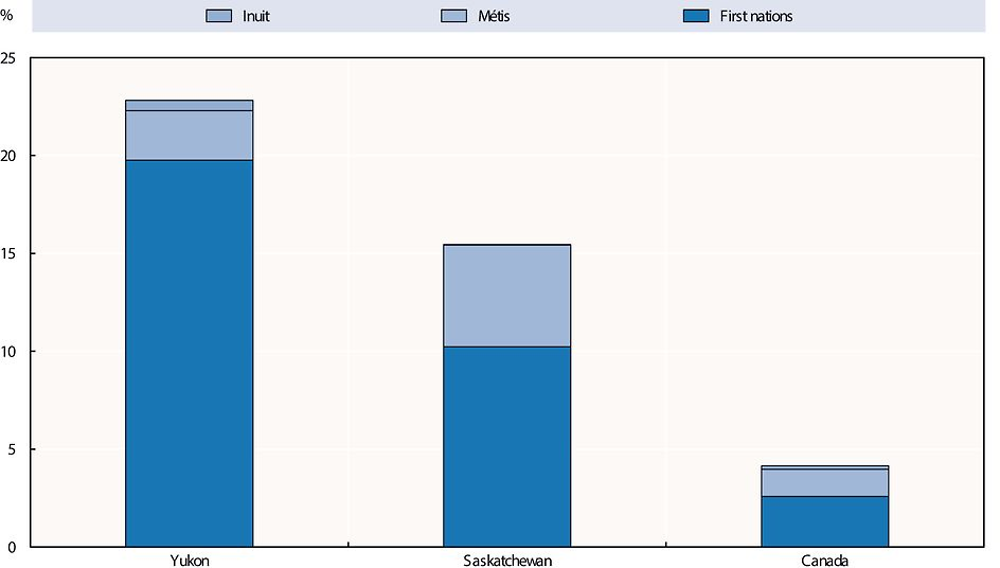
Source: Statistics Canada, 2011 National Household Survey.
In 2011, the indigenous population was younger than the non-indigenous population in both Saskatchewan and Yukon, with 53.7% of indigenous people in Saskatchewan and 42.5% in Yukon being aged less than 25 (29.8% and 27.2% in the non-indigenous population respectively).
Educational attainment
Figure 6.5 shows the gap that exists in terms of educational attainment between indigenous and non-indigenous populations aged 15 or more in Yukon, Saskatchewan and Canada as a whole. When looking at the share of individuals holding a postsecondary certificate, diploma or degree, this gap is wider in Yukon (22.6%) and in Saskatchewan (18.5%) than in Canada as a whole (16.8%). The same is true for individuals holding no certificate, diploma or degree.

Source: Statistics Canada, 2011 National Household Survey.
Labour market
As Figure 5.6 shows, in 2011, overall labour market participation and employment rates are higher in the Yukon and Saskatchewan when comparing the non-indigenous population to the rest of Canada. However, when looking at the indigenous population, one can see that both their participation and employment rates are well below the non-indigenous population. This holds in both the Yukon and Saskatchewan as well as when looking at the average of Canada.

Source: Statistics Canada, 2011 National Household Survey.
While youth unemployment increased in Canada as a whole between 2006-14 from 11.6% to 13.5%, it declined both in Saskatchewan and Yukon (see Figure 5.7), showing that these provinces were probably less impacted by the recent crisis.

* Excluding people living on-reserve.
Source: Statistics Canada, CANSIM table 282-0087, Labour Force Survey.
Employment and industrial structure
In 2014, the labour market structure of the two provinces presented a number of differences (Saskatchewan Bureau of Statistics, 2015b; YSB, 2015b). In terms of employment by sector, Yukon was characterised by high shares of employment in public administration, followed by trade and health care and social assistance, whereas in Saskatchewan employment was more concentrated in trade, health care and social assistance and construction (Figure 5.8).
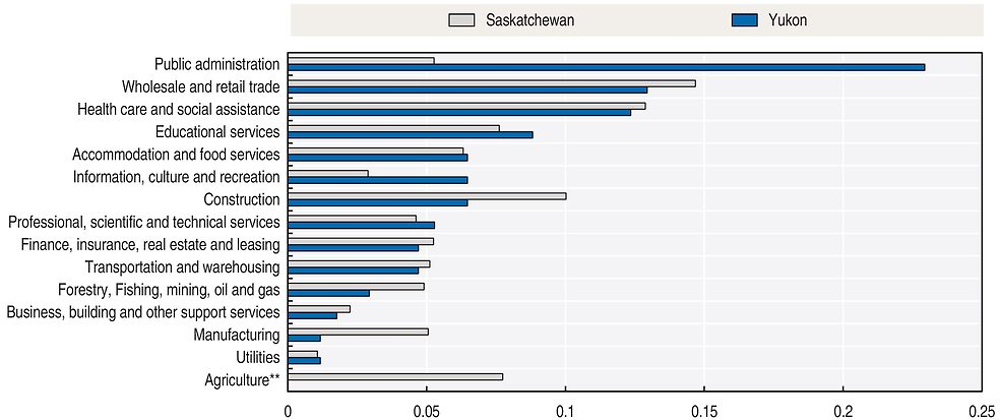
* Excluding people living on-reserve.
** Data not available for Yukon.
Source: Statistics Canada, CANSIM table 282-0012, Labour Force Survey; YSB (2015a).
Both Yukon and Saskatchewan had a higher proportion of workers registered as self-employed than the Canadian average (15.3%) at 16.5% and 19.4% respectively. As shown in Figure 5.9, in both Saskatchewan and Yukon, sales and service occupations account for the largest share of employment. Saskatchewan has a much higher share of employment in occupations unique to primary industries due to the importance of the extractive industries in the Province.
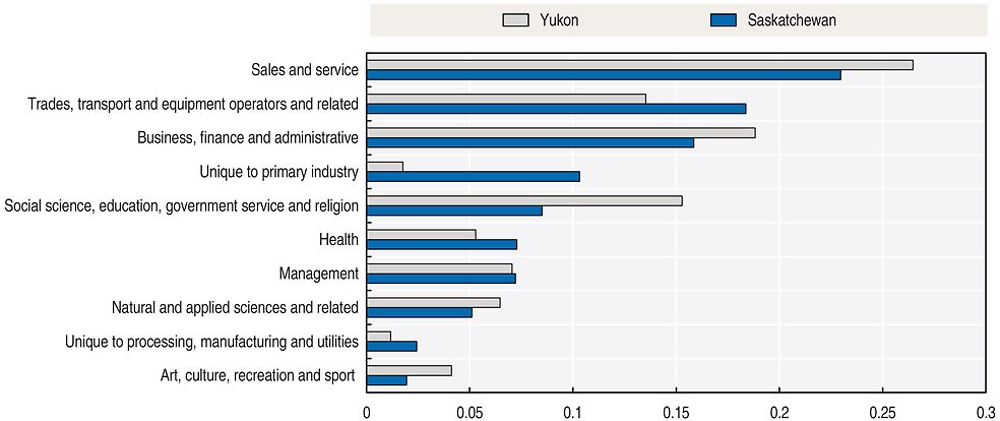
* Excluding people living on-reserve.
Source: Statistics Canada. Table 282-0232 – Labour force survey estimates (LFS).
Labour force dynamics
To supplement the above analysis, the OECD LEED Programme has developed a statistical tool to understand the balance between skills supply and demand within local labour markets (Froy, Giguère and Meghnagi, 2012). In the Canadian context, this tool can supplement the previous analysis to provide policy makers with an understanding of potential skills mismatches, which may be occurring at the sub-national level. It can also inform place-based policy approaches at the local level.
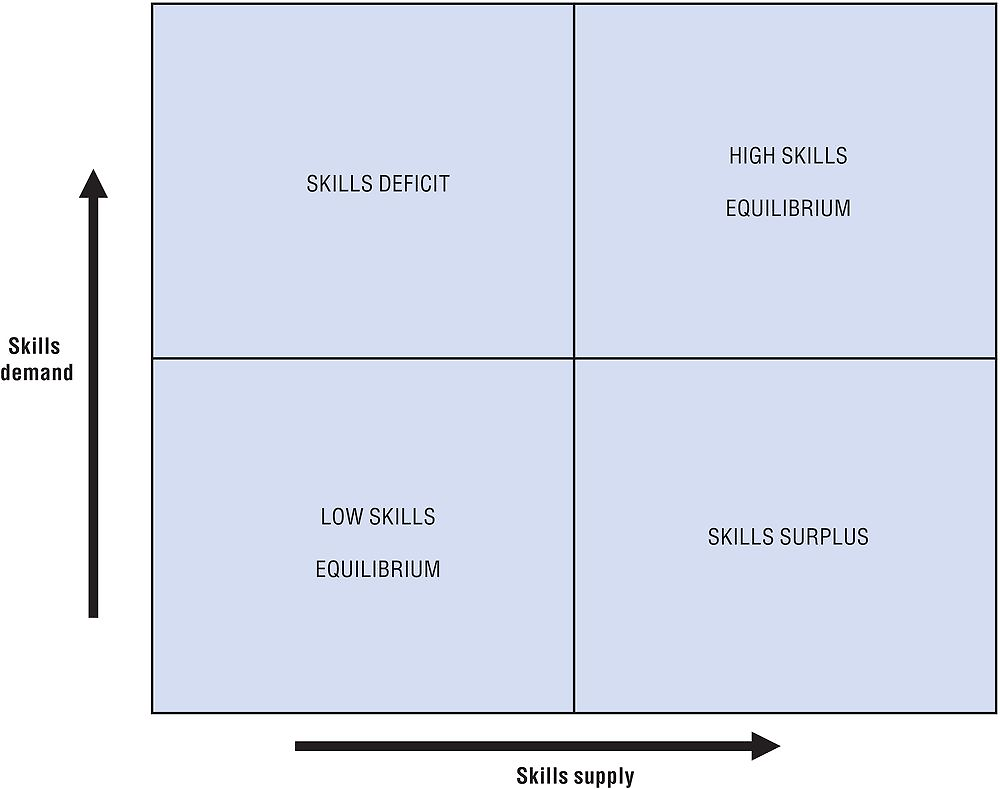
Source: Froy, F. and S. Giguère (2010), “Putting in Place Jobs that Last: A Guide to Rebuilding Quality Employment at Local Level”, OECD Local Economic and Employment Development (LEED) Working Papers, No. 2010/13, OECD Publishing, https://doi.org/10.1787/5km7jf7qtk9p-en.
Looking at the figure above, in the top-left corner (skills gaps and shortages), demand for high skills is met by a supply of low skills, a situation that results in reported skills gaps and shortages. In the top-right corner, demand for high skills is met by an equal supply of high skills resulting in a high-skill equilibrium. This is the most desired destination of all high performing local economies. At the bottom-left corner the demand for low skills is met by a supply of low skills resulting in a low-skill equilibrium. The challenge facing policymakers is to get the economy moving in a north-easterly direction towards the top‐right corner. Lastly, in the bottom-right corner, demand for low skills is met by a supply of high skills resulting in an economy where what high skills are available are not utilised. This leads to the out migration of talent, underemployment, skill under-utilisation, and attrition of human capital, all of which signal missed opportunities for creating prosperity.
The analysis is carried out at Territorial Level 3 regions (regions with populations ranging between 150 000-800 000). The supply of skills was measured by the percentage of the population in employment with postsecondary education. The demand for skills was approximated using a composite index: percentage of the population in employment having medium to high skilled occupations and GVA per worker (weighted at 0.25 and 0.75 respectively). The indices are standardised using the inter-decile method and are compared with the national median. Further explanations on the methodology can be found in Froy, Giguère and Meghnagi, 2012.
Source: Froy, F., S. Giguère and M. Meghnagi (2012), “Skills for Competitiveness: A Synthesis Report”, OECD Local Economic and Employment Development (LEED) Working Papers, No. 2012/09, OECD Publishing, https://doi.org/10.1787/5k98xwskmvr6-en.
This typology is applied to economic regions in Saskatchewan using the provincial median for comparison purposes in Figure 5.11. In analysing the results, one can see the Regina – Moose Mountain and falls Saskatoon-Biggar economic regions fall into the high-skills equilibrium quadrant, whereas Swift Current – Moose Jaw and Yorkton-Melville fall into a low-skills equilibrium, which indicates a prevalence of lower quality jobs. One would expect areas around Saskatoon and Regina to fall into a high-skills equilibrium as there is a larger proportion of the population with a high level of skills in these communities. There are challenges associated with this analysis as the regions cover do not necessarily correspond to travel to work areas. It was not possible to collect further disaggregated information due to data comparability issues.
Due to data availability and suppression issues, it was not possible to perform this data analysis in the Yukon.
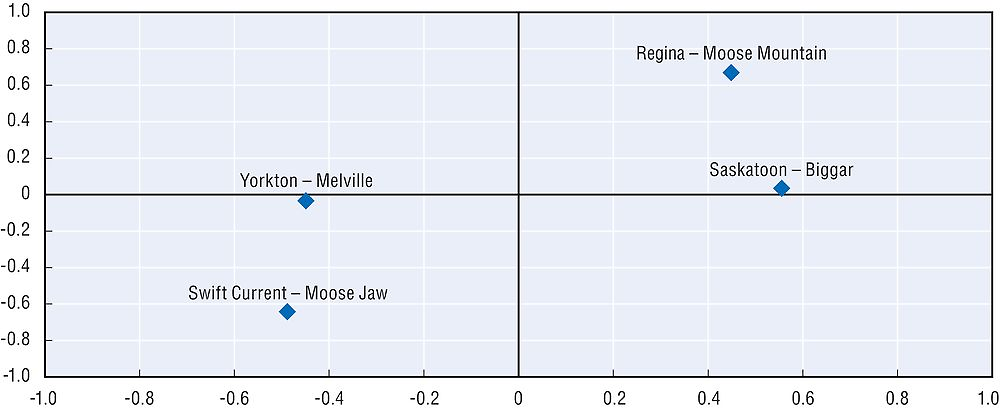
References
Anderson, A. (2004), “Migration and Mobility Between Reserve and City: A Survey of Whitecap Dakota/Sioux First Nations Residents in Saskatoon”, University of Saskatchewan, Saskatoon.
City of Saskatoon (2015), “First Nation Community Profile: Whitecap Dakota First Nation”, www.saskatoon.ca/sites/default/files/documents/community-services/planning-development/future-growth/urban-reserves-treaty-land-entitlement/fnp_whitecap_final.pdf.
City of Whitehorse (2015), “Whitehorse Community Profile”, http://profile.id.com.au/whitehorse.
Froy, F. and S. Giguère (2010), “Putting in Place Jobs that Last: A Guide to Rebuilding Quality Employment at Local Level”, OECD Local Economic and Employment Development (LEED) Working Papers, No. 2010/13, OECD Publishing, Paris, https://doi.org/10.1787/5km7jf7qtk9p-en.
Froy, F., S. Giguère and M. Meghnagi (2012), “Skills for Competitiveness: A Synthesis Report”,OECD Local Economic and Employment Development (LEED) Working Papers, No. 2012/09, OECD Publishing, Paris, https://doi.org/10.1787/5k98xwskmvr6-en.
Government of Yukon (2015a), “Graduation Rates 2014”, www.education.gov.yk.ca/graduation-rates.html.
Government of Yukon (2015b), “Yukon economic Outlook: January 2015”, Whitehorse, http://economics. gov.yk.ca/Files/2015/YukonEconomicOutlook_January2015.pdf.
Hemson Consulting Ltd. (2013), “City of Regina Population, Housing and Employment Forecasts and Land needs analysis to 2041, Final technical memorandum”, Toronto.
Klondike Development Organization (2013), “Dawson Employer Labour Market survey Report”, Dawson City.
National Resources Canada (2015), Regina Economic Profile, Government of Canada, Ottawa.
Regina Regional Opportunities Commission (2015), “Regina Regional Economic Profile”, www.economic developmentregina.com/assets/EconomicProfileAugust2015.pdf.
Saskatchewan Bureau of Statistics (2015a), Monthly Statistical Review, Volume 41, No. 11, November 2015, ISSN 0706–7836, Government of Saskatchewan.
Saskatchewan Bureau of Statistics (2015b), “Economic Review 2014”, Number Sixty-Eight, Government of Saskatchewan, www.stats.gov.sk.ca/stats/ER2014.pdf.
Skookum Jim Friendship Centre (2015), “About Us”, http://skookumjim.com/about-us/.
The Canadian Business Journal (2011), “Whitecap Development Corporation”, Volume 4, Issue 11, Mississauga.
YSB (2015a), “Population Report”, June 2015, Yukon Bureau of Statistics, Whitehorse, www.eco.gov.yk.ca/fr/pdf/populationJun_2015.pdf.
YSB (2015b), “Yukon Employment Historical Data 2005-2014”, Yukon Bureau of Statistics, Whitehorse, www.eco.gov.yk.ca/fr/pdf/Historical_LFS_2014_r.pdf.
YSB (2013), “Business Survey Report”, Yukon Bureau of Statistics, Whitehorse, www.eco.gov.yk.ca/pdf/2013_Business_Survey_Report.pdf.
Whitecap Dakota First Nation (2015), “About”, www.whitecapdakota.com/about/about-us/.
